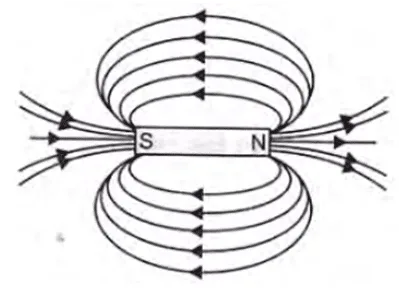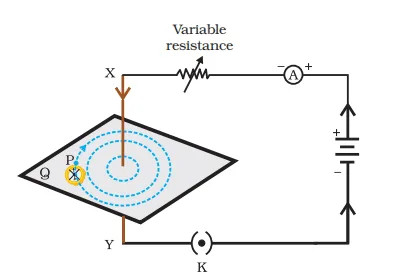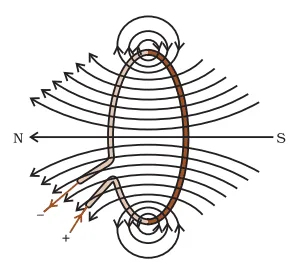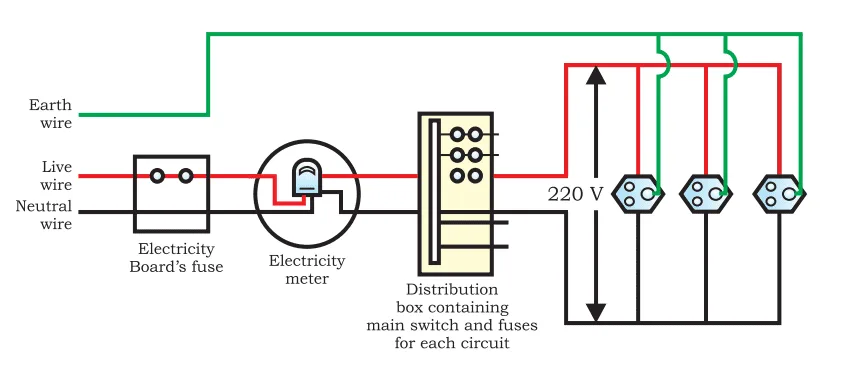Magnetic Effects of Electric Current Class 10 Notes | CBSE Science Chapter 13 Simplified (2025–26)
Magnetic Effects of Electric Current Notes
Hello, Class 10 Champs! Ready to conquer Chapter 13 – Magnetic Effects of Electric Current for your CBSE 2024–25 board exams?⚡ You're in the right place!
No more endless scrolling or struggling with complex textbook jargon. Our simplified notes PDF is packed with crystal-clear concepts, easy diagrams, exam-focused tips, and explanations aligned with the latest syllabus. Whether you're curious about magnetic fields or trying to decode the right-hand rule, this guide will energize your preparation.
Download your free notes now and dive into the fascinating world of electromagnetism. From electric current to magnetic effects, we've made it all shockingly simple. Let’s spark your success—one concept at a time!
| Subject | Science (Physics) |
| Class | 10 |
| Board | CBSE & State Boards |
| Chapter No. | 12 |
| Chapter Name | Magnetic Effect of Electric Current |
| Type | Notes |
| Session | 2025-26 |
Table of Contents
Magnetic Field and Field Lines
Magnetic field: The region surrounding a magnet, in which the force of the magnet can be detected is called its magnetic field.
Field lines: Field lines are used to represent a magnetic field. A field line is a path along which a hypothetical free north pole would tend to move.
Magnetic field lines due to a bar magnet:

Properties of field lines:
- The magnetic field is a quantity that has both direction and magnitude.
- It is taken by convention that the field lines emerge from the north pole and merge at the south pole. Inside the magnet, the direction of field lines is from its south pole to its north pole. Thus the magnetic field lines are closed curves.
- The relative strength of the magnetic field is shown by the degree of closeness of the field lines. The closer the field lines, the stronger the strength of the magnetic field.
- No two field lines cross each other. (If they cross, it would mean that at the point of intersection, the magnetic compass needle would point toward two directions, which is not possible.
Magnetic Field due to a Current Carrying Conductor
Magnetic Field due to a Current through a Straight Conductor

A pattern of concentric circles indicating the field lines of a magnetic field around a straight conducting wire. The arrows in the circles show the direction of the field lines.
The strength of the magnetic produced by a straight conductor carrying current depends on:
- The strength of a field is directly proportional to the current passing through the conductor.
- Strength of the field is inversely proportional to the perpendicular distance from the conductor.
Right-Hand Thumb Rule
The direction of the magnetic field produced by the current-carrying conductor can be found by applying the Right-Hand Thumb Rule. According to this rule, if we are holding a current-carrying straight conductor in our right hand such that the thumb points towards the direction of the current, then our fingers will wrap around the conductor in the direction of the field lines of the magnetic field.
Magnetic Field due to a Current through a Circular Loop

- Every point on the wire carrying current would give rise to the magnetic field appearing as straight lines at the center of the loop.
- By applying the right hand rule, it is easy to check that every section of the wire contributes to the magnetic field lines in the same direction within the loop.
- We know that the magnetic field produced by a current-carrying wire at a given point depends directly on the current passing through it. Therefore, if there is a circular coil having n turns, the field produced is n times as large as that produced by a single turn.
Magnetic Field due to a Current in a Solenoid
Solenoid: A coil of many circular turns of insulated copper wire wrapped closely in the shape of a cylinder is called a solenoid.

One end of the solenoid behaves as a magnetic north pole, while the other behaves as the south pole. The field lines inside the solenoid are in the form of parallel straight lines. This indicates that the magnetic field is the same at all points inside the solenoid. That is, the field is uniform inside the solenoid.
A strong magnetic field produced inside a solenoid can be used to magnetize a piece of magnetic material, like soft iron, when placed inside the coil. The magnet so formed is called an electromagnet.
The strength of a magnetic field is directly proportional to:
- The number of turns in the solenoid.
- The current in the solenoid.
Force on a Current-Carrying Conductor in a Magnetic Field
Experiment to show that force is exerted on a current-carrying conductor when placed perpendicular to a magnetic field

Take a small metal rod AB and suspend it from a stand with the help of two connected wires. Put the in between the horseshoe magnet in such a way that the rod remains in between the two poles. Pass the current in the rod through the two wires. You would find that the rod is deflected towards the left. Now reverse the direction of the current, and the rod is deflected in opposite direction. This show that a force is experienced by a current-carrying conductor in the magnetic field.
Factors on which Force exerted on Current carrying conductor in magnetic field depend:
- The magnitude of the force is the highest/maximum when the direction of the current is at right angles/perpendicular to the direction of the magnetic field.
- The magnitude of the force is minimum when the direction of the current is parallel to the direction of the magnetic field.
Fleming’s left-hand rule: Stretch the forefinger, the middle finger, and the thumb of the left hand mutually perpendicular to each other in such a way that the forefinger points the direction of the magnetic field, the middle finger points the direction of current (opposite to the direction of flow of electrons) then the thumb will point the direction of the force on the conductor.
Domestic Electric Circuits
The standard color code for
- Live wire – Red
- Neutral – Black
- Earth – Green
The potential difference between Live wire and Neutral wire is 220V.
Safety Measures:
i. Earthing
The metallic case of an electrical appliance is earthed because metals are good conductors of electricity and in case if current exceeds i.e., live wire touches the metallic case of an appliance, then due to earthing all the excess amount of current flows down to the earth and we prevent ourselves from an electric shock.

ii. Fuse
It is a safety device that protects the circuit in case excess current flows through the circuit. When a high current flows through a circuit, the fuse wire gets heated and melts. This breaks the circuit and the current stops flowing.
Overloading
- Cause: Happens when too many devices or appliances are connected to a single socket or circuit, drawing more current than the circuit is designed to handle. It can also occur when there is a sudden spike in supply voltage.
- Effect: This increased current flow heats the wires beyond their safe limit, which can cause the insulation to melt and may lead to fires.
Short-Circuiting
- Cause: Occurs when the live (positive) wire and neutral (negative) wire come into direct contact, usually due to damaged insulation or a fault in an appliance.
- Effect: Creates a path with very low resistance, causing a sudden surge in current flow that can damage appliances, wires, and pose fire risks.
Both issues are prevented by fuses or circuit breakers that stop the current flow.
Overloading can be avoided by the following methods:
- Avoid connecting too many appliances to a single socket or circuit.
- Use appliances with appropriate power ratings that match the circuit’s capacity.
- Turn off appliances when not in use to reduce unnecessary load.
- Ensure proper wiring and insulation to handle the required current.
📘 Chapter 13: Magnetic Effects of Electric Current
Subject: Class 10 Science (Physics)
Board: CBSE
Book: NCERT
Chapter: 13
🔹 Intext Questions – Page 224
Q1. Why does a compass needle get deflected when brought near a bar magnet?
✅ Answer:
Because the magnetic field of the bar magnet exerts a force on the magnetic needle, causing it to align with the field.
🔹 Intext Questions – Page 228
Q1. Draw a magnetic field line around a current-carrying straight conductor.
✅ Answer:
The magnetic field lines form concentric circles centered on the conductor.
Q2. List the properties of magnetic field lines.
✅ Answer:
-
They form closed loops.
-
They do not intersect.
-
The direction is from north to south outside the magnet.
-
Closer lines indicate stronger field.
Q3. Why don’t two magnetic field lines intersect each other?
✅ Answer:
Because if they did, it would imply two directions of the magnetic field at the same point, which is not possible.
🔹 Intext Questions – Page 229
Q1. Consider a circular loop of wire lying in the plane of the table. Let the current pass through the loop clockwise. What will be the direction of the magnetic field inside and outside the loop?
✅ Answer:
Inside the loop – downward (into the table); outside – upward (out of the table), by Right-hand rule.
Q2. The magnetic field in a given region is uniform. Draw a diagram to represent it.
✅ Answer:
Parallel, equally spaced straight lines in the same direction.
Q3. Choose the correct option:
The magnetic field inside a long straight solenoid is
(a) zero
(b) decreases with distance
(c) same at all points
(d) increases with distance
✅ Answer: (c) same at all points
🔹 Intext Questions – Page 231
Q1. Which of the following properties of a proton can change while it moves freely in a magnetic field?
(a) mass
(b) speed
(c) velocity
(d) momentum
✅ Answer: (c) velocity and (d) momentum
Q2. In Activity 13.7, how do we think the displacement of rod AB will be affected if (i) current in rod AB is increased; (ii) a stronger magnetic field is used; (iii) the length of the rod is increased?
✅ Answer:
The displacement will increase in all three cases because the force increases (F = BIL).
Q3. A positively charged particle is moving due north in a magnetic field. What is the direction of the magnetic force acting on it if the field is directed vertically downward?
✅ Answer:
Using Fleming’s left-hand rule, the force acts toward the west.
🔹 Intext Questions – Page 233
Q1. State Fleming’s Left-Hand Rule.
✅ Answer:
Stretch the thumb, forefinger, and middle finger of your left hand perpendicular to each other.
-
Forefinger = direction of magnetic field
-
Middle finger = current
-
Thumb = force (motion)
Q2. What is the principle of an electric motor?
✅ Answer:
A current-carrying conductor placed in a magnetic field experiences a force that causes rotation.
Q3. What is the role of a split ring in an electric motor?
✅ Answer:
It reverses the direction of current in the coil every half turn to maintain continuous rotation.
🔹 Intext Questions – Page 236
Q1. Explain different ways to induce current in a coil.
✅ Answer:
-
Moving a magnet toward or away from a coil
-
Moving the coil in a magnetic field
-
Changing the current in a nearby coil
🔹 Intext Questions – Page 237
Q1. State the principle of an electric generator.
✅ Answer:
Electromagnetic induction – a current is induced in a coil when there is a relative motion between the coil and a magnetic field.
Q2. Name some sources of direct current.
✅ Answer:
Cells, batteries, DC generators
Q3. Which sources produce alternating current?
✅ Answer:
AC generators, power plants
Q4. Choose the correct option:
A rectangular coil of copper wire is rotated in a magnetic field. The direction of induced current changes once in each:
(a) two revolutions
(b) one revolution
(c) half revolution
(d) one-fourth revolution
✅ Answer: (c) half revolution
🔹 Back Exercise Questions (Page 240–241)
Q1. Which of the following correctly describes the magnetic field near a long straight wire?
✅ Answer:
(c) The field consists of concentric circles centered on the wire.
Q2. The phenomenon of electromagnetic induction is:
✅ Answer:
(c) the production of induced current in a coil due to relative motion between a magnet and the coil.
Q3. The device used for producing electric current is called a:
✅ Answer:
(d) generator
Q4. The essential difference between an AC and a DC generator is:
✅ Answer:
(c) AC generator has slip rings; DC generator has a commutator.
Q5. At the time of short circuit, the current in the circuit:
✅ Answer:
(c) increases heavily
Q6. State whether the following statements are true or false.
(a) An electric motor converts mechanical energy into electrical energy. ❌
(b) An electric generator works on the principle of electromagnetic induction. ✅
(c) The field at the center of a long circular coil is zero. ❌
(d) The field lines of a magnetic field never intersect each other. ✅
Q7. List three sources of magnetic fields.
✅ Answer:
-
Bar magnet
-
Current-carrying conductor
-
Solenoid
Q8. How does a solenoid behave like a magnet? Can you determine the north and south poles of a current-carrying solenoid with a bar magnet?
✅ Answer:
Yes. One end behaves like the north pole and the other like the south pole. It behaves like a bar magnet.
Q9. When is the force experienced by a current-carrying conductor placed in a magnetic field largest?
✅ Answer:
When the conductor is perpendicular to the magnetic field.
Q10. Imagine that you are sitting in a chamber with a current-carrying wire above you. What will be the direction of magnetic field at your location?
✅ Answer:
Using Right-Hand Thumb Rule – direction is from west to east if current is from south to north.
Q11. Draw a labelled diagram of an electric motor. Explain its principle and working. What is the function of a split ring?
✅ Answer:
-
Diagram
-
Principle: force on current-carrying conductor
-
Split ring reverses direction of current
Q12. Name some devices in which electric motors are used.
✅ Answer:
-
Fans
-
Mixers
-
Washing machines
-
Pumps
Q13. A coil of insulated copper wire is connected to a galvanometer. What will happen if a bar magnet is:
(i) pushed into the coil
(ii) withdrawn from the coil
(iii) held stationary inside the coil?
✅ Answer:
(i) Galvanometer shows deflection
(ii) Deflection in opposite direction
(iii) No deflection
Q14. Two circular coils A and B are placed close to each other. If current in coil A is changed, will some current be induced in coil B? Explain.
✅ Answer:
Yes, due to electromagnetic induction.
Q15. State the rule to find the direction of a:
(a) magnetic field around a current-carrying straight conductor
(b) force experienced by a current-carrying conductor in a magnetic field
✅ Answer:
(a) Right-Hand Thumb Rule
(b) Fleming’s Left-Hand Rule
Q16. Explain the underlying principle and working of an electric generator by drawing a labeled diagram. What is the function of brushes?
✅ Answer:
-
Principle: Electromagnetic Induction
-
Brushes provide contact between slip rings and external circuit
Q17. When does short circuit occur?
✅ Answer:
When live and neutral wires come in direct contact.
Q18. What is the function of an earth wire? Why is it necessary to earth metallic appliances?
✅ Answer:
To prevent electric shock by grounding excess current.
🔦 CBSE Class 10: Chapter 13 – Magnetic Effects of Electric Current
📘 Past Year Board Questions (PYQs)
📅 Based on exams from 2016–2024
🟢 1-MARK QUESTIONS
-
What is the function of the earth wire in electrical instruments?
📅 CBSE 2018, 2022
✅ Ans: It provides a path for current to flow safely to the ground in case of a fault. -
What will be the direction of the magnetic field if the current is flowing vertically downward in a straight conductor?
📅 CBSE 2020
✅ Ans: Using the right-hand thumb rule, the magnetic field will be in concentric circles in a clockwise direction around the wire. -
Name a device that converts electrical energy into mechanical energy.
📅 CBSE 2016, 2021
✅ Ans: Electric motor -
What is the frequency of AC in India?
📅 CBSE 2023
✅ Ans: 50 Hz
🟡 2-MARK QUESTIONS
-
State the rule to find the direction of magnetic field around a current-carrying conductor. Draw the diagram.
📅 CBSE 2019
✅ Ans: Right-hand thumb rule: Thumb → current; curled fingers → magnetic field. -
Why don’t two magnetic field lines intersect each other?
📅 CBSE 2018
✅ Ans: Because that would imply two directions of the magnetic field at one point, which is not possible. -
What is the function of the split ring in an electric motor?
📅 CBSE 2016
✅ Ans: It reverses the direction of current every half rotation to maintain continuous rotation in the same direction.
🔵 3-MARK QUESTIONS
-
Draw the magnetic field lines around a bar magnet. List two properties of magnetic field lines.
📅 CBSE 2018, 2021
✅ Ans:
-
They form closed curves.
-
They never intersect.
-
The field is stronger where the lines are closer.
-
What is the magnetic field? How is its direction determined?
📅 CBSE 2020
✅ Ans: Magnetic field is the region around a magnet where its force can be detected. Direction is given by a compass needle or right-hand rule. -
List two causes of short circuit. What is the role of a fuse in an electric circuit?
📅 CBSE 2022
✅ Ans:
-
Wire insulation damage
-
Overloaded circuits
Fuse melts to break the circuit and prevent damage.
🔴 5-MARK QUESTIONS
-
(a) What is electromagnetic induction?
(b) Describe an activity to demonstrate it.
(c) Name the rule used to find the direction of induced current.
📅 CBSE 2021, 2023
✅ Ans:
-
Production of current due to change in magnetic field
-
Coil and magnet experiment
-
Fleming’s right-hand rule
-
Draw a labelled diagram of an electric motor. Explain its working and state the function of a split ring.
📅 CBSE 2020, Sample Paper 2022
✅ Ans:
-
Motor converts electrical energy into mechanical
-
Split ring reverses current every half turn
-
Explain the principle, construction, and working of an electric generator with a diagram. What is the function of brushes?
📅 CBSE 2018, 2019
✅ Ans:
-
Principle: Electromagnetic induction
-
Diagram: coil, magnet, slip rings, brushes
-
Brushes transfer current to external circuit
-
Differentiate between AC and DC current. Draw diagrams of each. Mention their advantages.
📅 CBSE 2017
✅ Ans:
| AC (Alternating Current) | DC (Direct Current) |
|--------------------------|---------------------|
| Changes direction | Constant direction |
| Produced by generator | Produced by battery |
-
What happens when a current-carrying conductor is placed in a magnetic field? Explain with Fleming’s left-hand rule and give one application.
📅 CBSE 2020
✅ Ans:
The conductor experiences a force perpendicular to both current and field direction. Used in electric motors.
✅ High-Yield Topics from CBSE Boards:
| Topic | Marks | Frequency |
|---|---|---|
| Magnetic field lines & their properties | 1–3 | High |
| Right-hand thumb rule / Left-hand rule | 1–3 | Very High |
| Electric motor & generator (diagram + working) | 3–5 | Very High |
| Electromagnetic induction | 3–5 | High |
| Fuse, short circuit, safety devices | 1–2 | Medium |
| AC vs DC + diagrams | 3–5 | Moderate |



Comments
Post a Comment